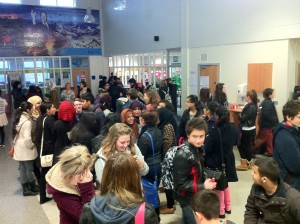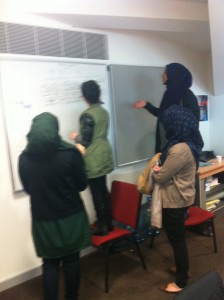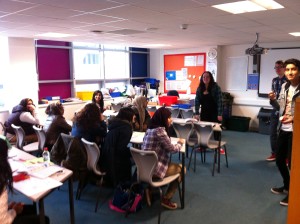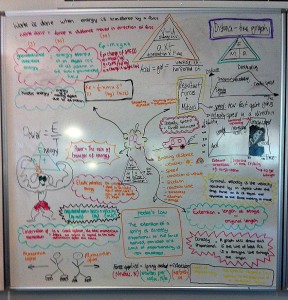
…students came back into school to make it not like school.
This week-end I was privileged to witness one of the most exciting exemplifications of self-determined learning I’ve yet to see. In OPEN, I write about the inevitable shift, from Pedagogy (tutor-directed learning), to Andragogy (self-directed learning), to Heutagogy (self-determined learning). I argue that our formal institutions will increasingly have to follow learner needs and interests, simply because, when we’re learning socially, it’s all self-determined. So, we can expect that we will demand more of what works for us socially, when we’re in a more formal space.
However, self-directed or self-determined learning is generally considered the preserve of adults. Young learners are not supposed to know what their learning needs are and therefore, God forbid, left to their own devices they might just mess about, ‘wasting’ learning time.
Well, this Saturday I saw the epitome of high-energy, purposeful learning – and there was hardly an adult in sight.

Spontaneous learning breaks out
Matthew Moss High School, in Rochdale, UK, set up an experiment just over a month ago. ‘D6’ was an offer to all students aged between 13-16. The idea was that school would be opened on a Saturday morning, ‘staffed’ by 17 year-old students from the local community college, who would act as learning coaches. These coaches would ordinarily have minimum-wage week-end jobs in shops and fast-food outlets, so MMHS Principal, Mark Moorhouse, in a moment of inspiration, reasoned that working as learning coaches might appeal, and set about recruiting up to 40 young learning coaches.
But Mark has been determined that this shouldn’t simply be an extension of school. So, no uniforms, no ‘curriculum’, and an emphasis upon social learning (free snacks and drinks laid on). The intention was to see what would happen if coaches and learners worked it out for themselves. A single days training was offered to the young coaches and then they were introduced to students…….
The first challenge would be: why would anyone turn up? MMHS is in an economically disadvantaged, working-class area of Rochdale, and one would be forgiven for wondering which students in their right minds would put in another shift on a day off? The answer, after little over a month, is 184 of them. The second challenge was this: how would barely trained, barely out of high school themselves, coaches lead learning? The answer was that they wouldn’t. A coach I spoke to summed up their dilemma: ‘For the first session, I’d prepared some lesson plans, but I realised that was pointless, because what they wanted to learn wasn’t what I’d prepared. So, me and the other coaches realised we’d just need to be flexible, and not get hung up on being ‘experts’.
The powerfully moving thing to witness was how, when allowed to grow organically, young learners will naturally adopt learning strategies that we know are the most effective. I saw peer learning everywhere; I saw friendship-based study groups in every room. Indeed learning with friends – and forming friendships with coaches – was perhaps the dominant relational factor throughout. Student needs didn’t fit neatly into ‘subjects’. One coach I spoke to had been asked for help with everything from Science, Maths, English… and Dance. She seemed totally unfazed by these demands.

Spot the student; spot the coach
Because if learners had spontaneously shaped effective learning strategies, so too had coaches. These seventeen year-olds (who didn’t know each other prior to signing up for this unusual Saturday job) had quickly identified each others strengths: Joe was the guy for the whiteboard explanations; Rachel was good at spotting the students who were struggling; Emma was great at doing mind-maps..and if no-one in this room could help students, one of their mates down the corridor probably knew what to do.
The result was a beautiful river of learning – students and coaches constantly in flow, spontaneously ‘hacking’ their learning, moving fluidly from one group to another- I foolishly called them ‘classes’, but nothing of what I saw resembles a conventional school, other than the building it was happening in.
One of the students I spoke to said that her marks since attending D6 had risen dramatically. She put at least some of this down to the fact that she didn’t have an issue telling her coach she didn’t get it, while she wouldn’t do the same in her teacher’s class, for fear of holding the others back. A student, with autism, said that, because the coach was almost the same age as himself, he felt more relaxed, ‘and I think you learn better when you’re relaxed’. Oh yes, you do.

But here’s the really exciting part of this experiment: it hasn’t even begun to realise its potential. Due to the age-range and the time of year, much of the student’s interest was in exam preparation – and there’s nothing wrong with that. There was also a strong STEM emphasis within the coaches skills. But, when the pressure of exams subsides, when numbers expand to younger students, when that arts are included, when interests become passion-driven, not just performance-driven, and learning ‘levels’ break free of school parameters – as we’ve seen with the maker movement – that’s when this thrilling experiment will take off.
Two questions remain: first, is learning really self-determined when there are so many coaches present? Personally, I think so – after all, none of us truly learn independently. I prefer to think of heutagogy as interdependent, not independent. The challenge is in making learner interests drive the enquiry, not the other way round.
The second question is a bit trickier: if school can be made to be ‘not-school’, can the not-school be brought back into school? Can you take this fluid learning and bring it into the mainstream without distorting it? I’d like to think so. And my sense, from talking to some of the 184 attendees this Saturday, was that they’d like it to be so, too.

This is wonderful to read. Quick, let’s get it in the front of politicians and policy makers. One of the problems we’ve encountered with self-determined learning is that people think that it is purely for adults. That kids have to go through pedagogy and andragogy to get to it, like graduating to solids from milk and puree. Kid before they go to school are superb learners. Watch any three year old, or less for that matter. And we don’t forget it, which is what this great story shows.
A friend of mine reckons that one of the best examples of self-determined learning is car theft. No matter what the manufacturers throw up the car thieves keep finding ways to steal cars. Its the same with learning new games and apps and so on.
We ‘adults’ have a lot to learn:))
Stewart,
You have to see it for yourself when you come over!
@David – I enjoyed reading this and one comment stood out “young learners will naturally adopt learning strategies that we know are the most effective”.
My own experience and now passion is for sharing a concept I call Learning Intelligence, LQ for short. I define this as the ability of the learner to manage their learning environment to meet their learning needs. High LQ = learning, no matter what! This is an perfect example of LQ in action. Well done to all those involved. Now how do we move this into the central arena?
For anyone interested in LQ I have written over 20 articles covering the attitudes, aptitudes and skills associated with LQ and you can find them on my blog.
The link to the original article is: http://wp.me/p2LphS-3p
The link to “The Need for Learning Intelligence as a Concept” is: http://wp.me/p2LphS-gY
Comments and questions always welcome.
‘Can the not-school be brought back into school?’ … undoubtedly yes if enough of us can articulate as well as you do how this enriches our currently outdated system.
This is such an exciting case study. It’s interesting how some of the dynamics of online social engagement has been brought into a physical learning space.
Inspirational.
Craig, It really is. Well worth visiting!